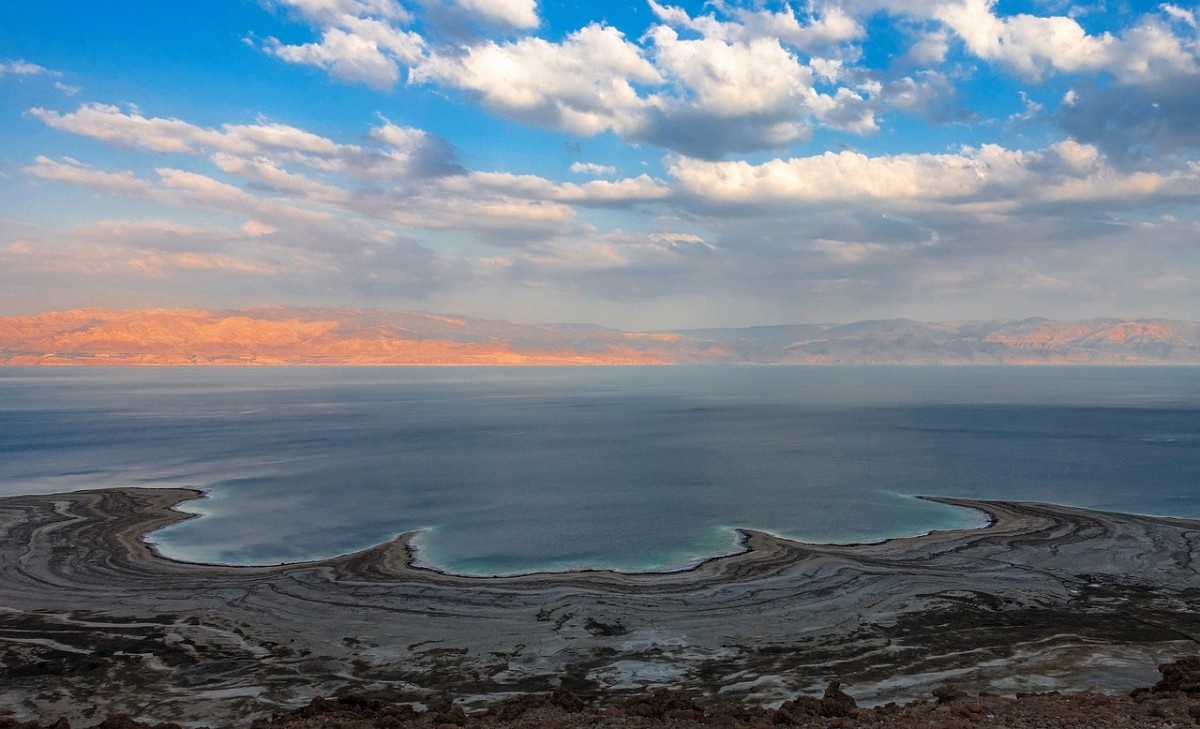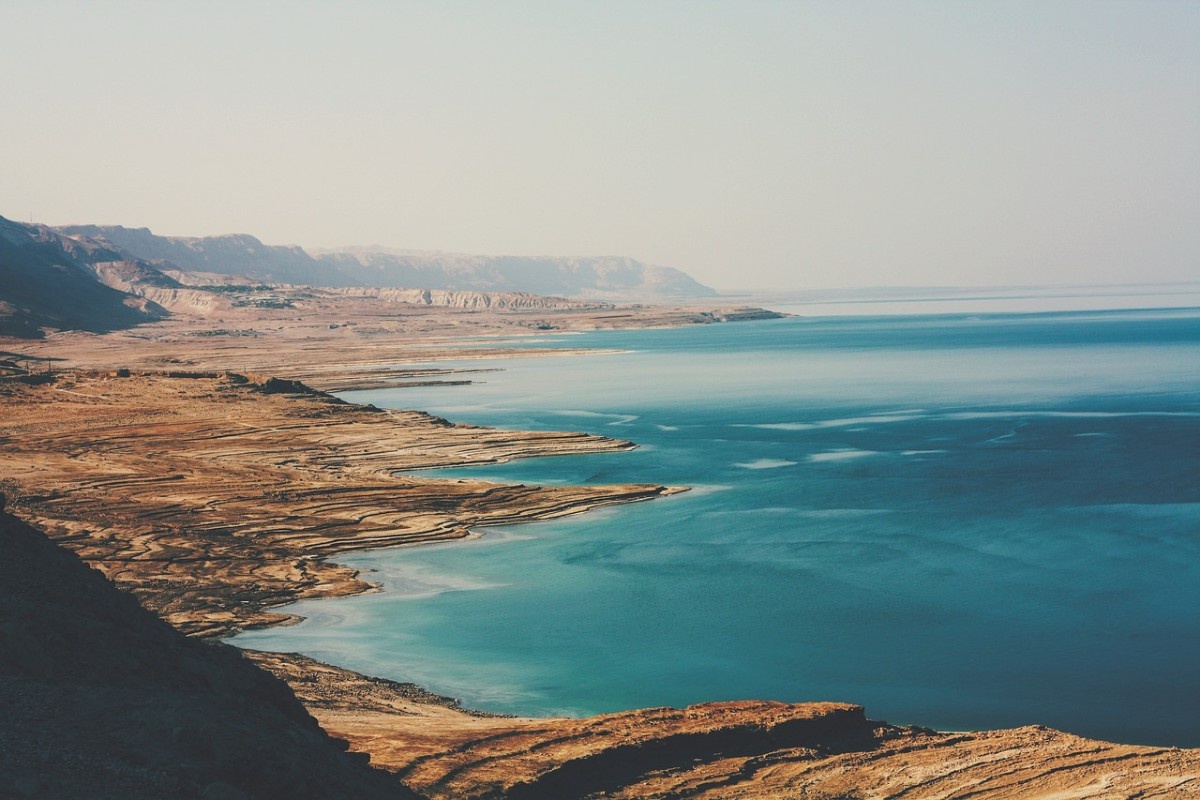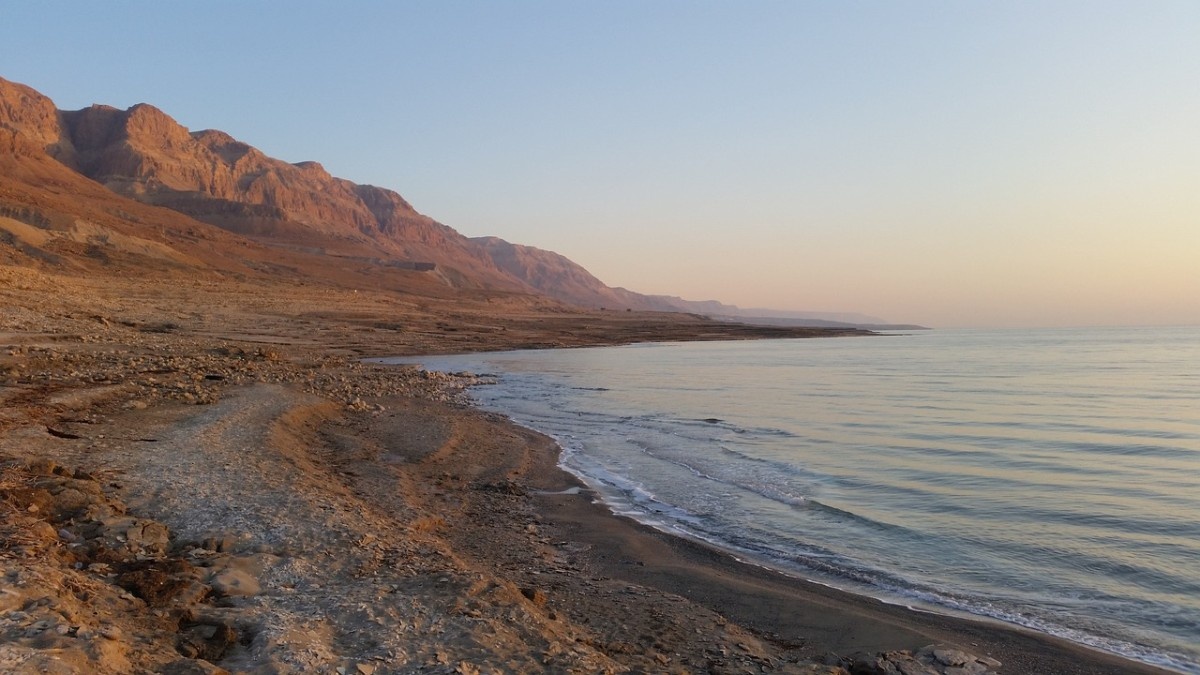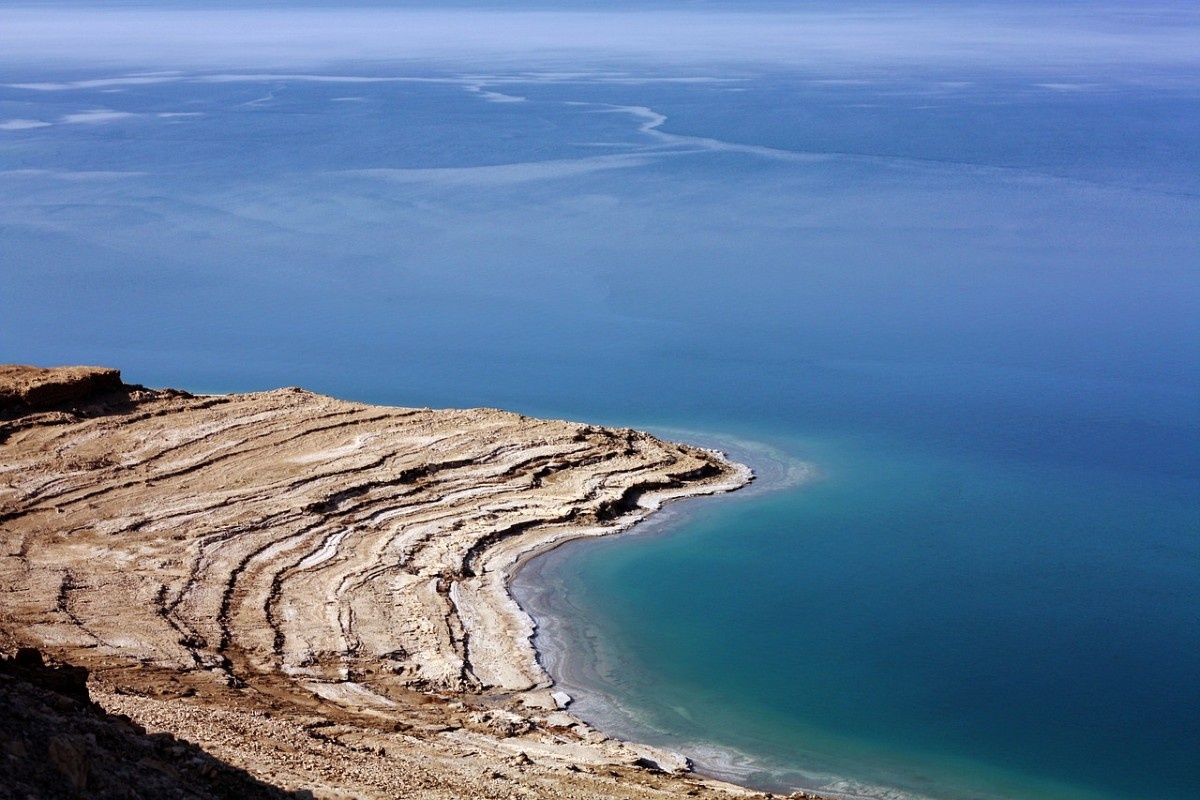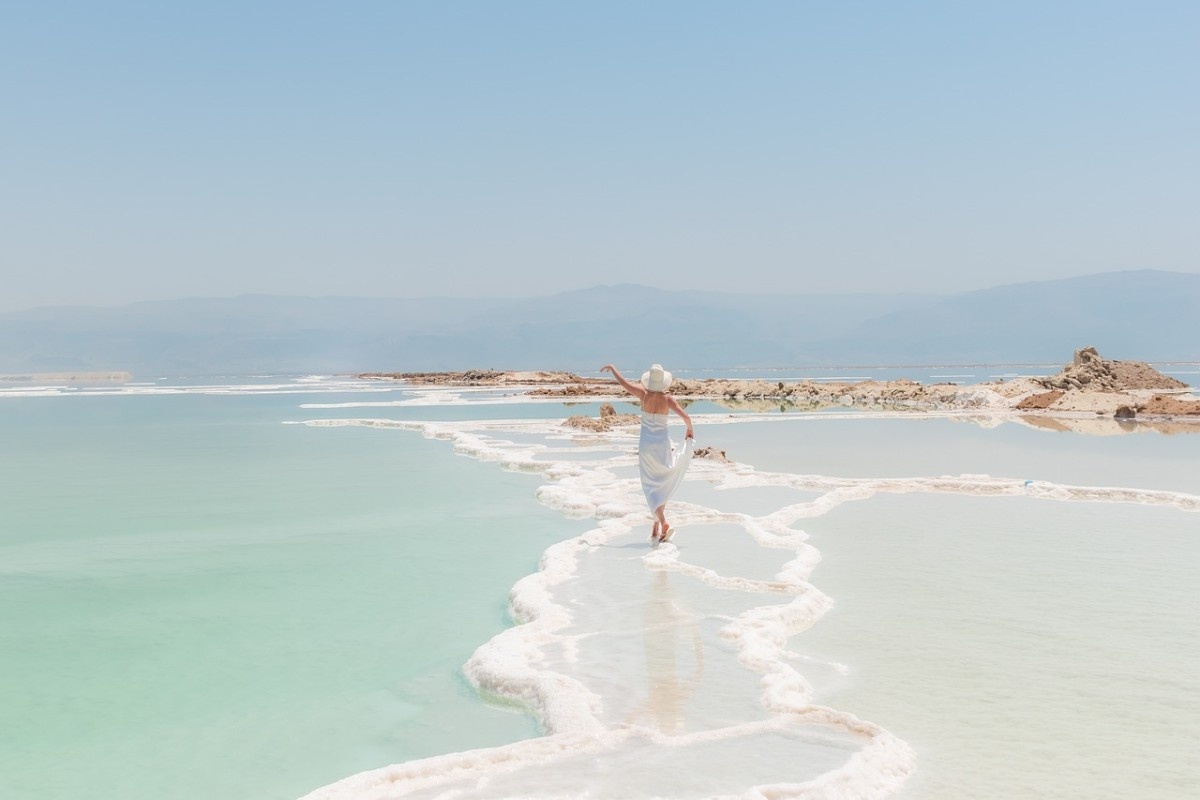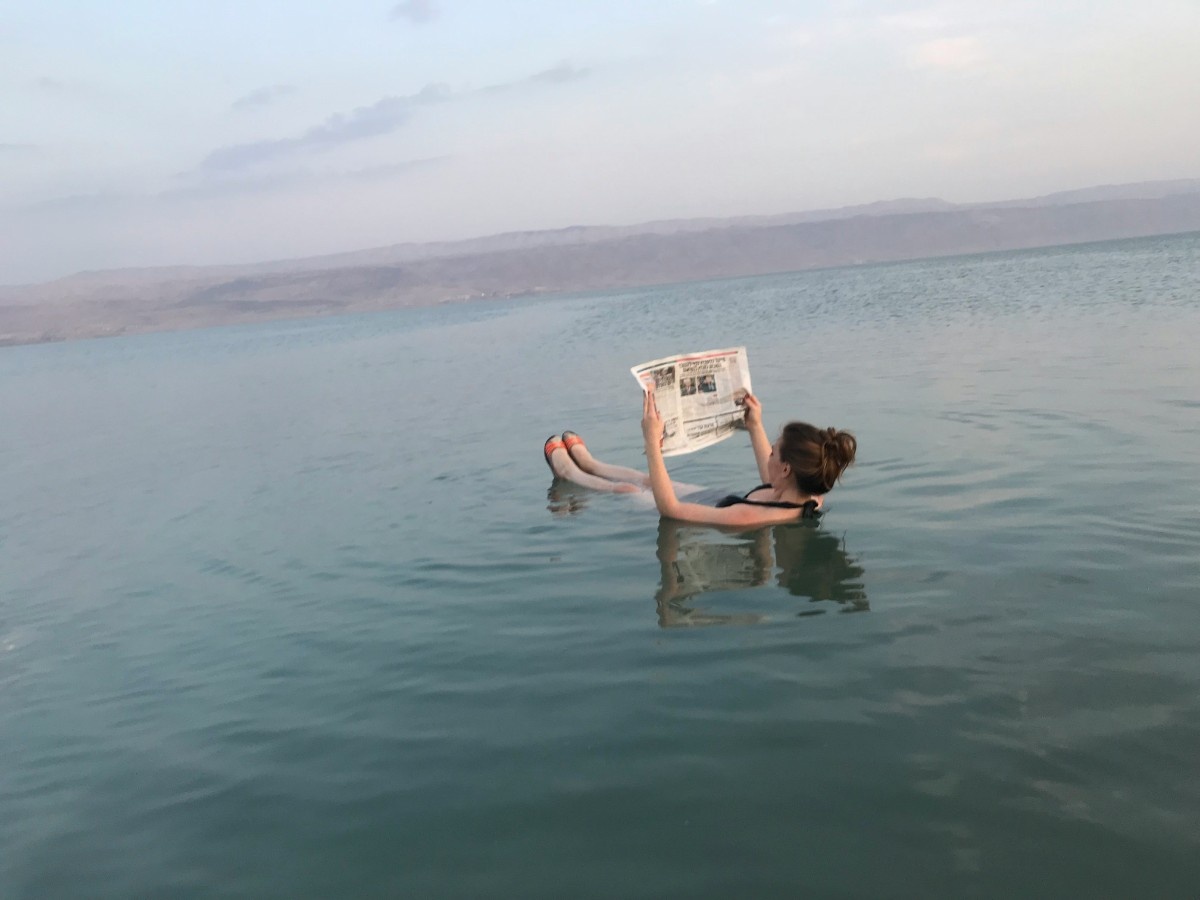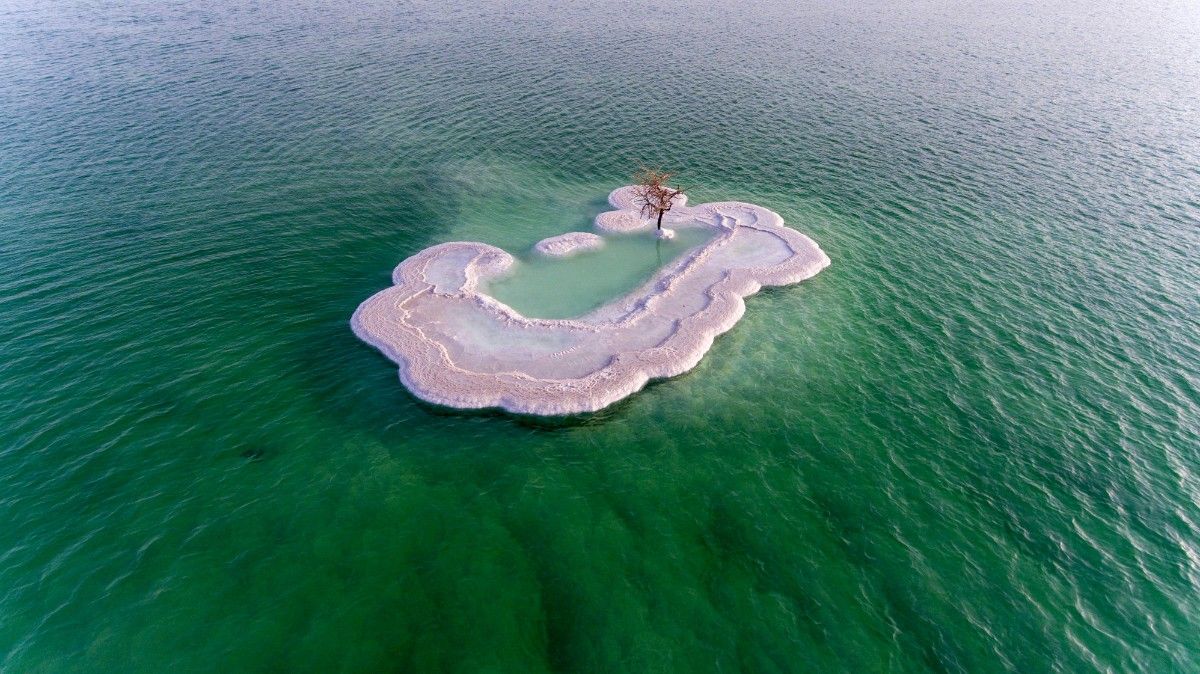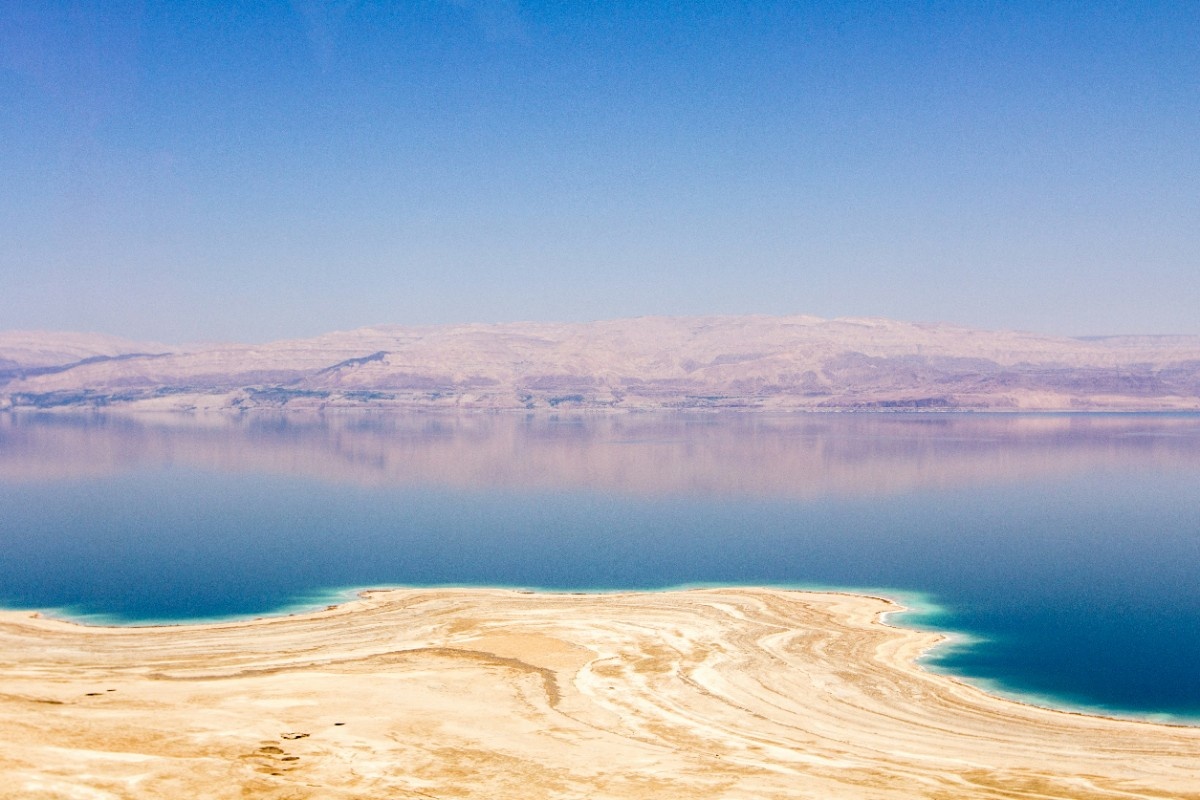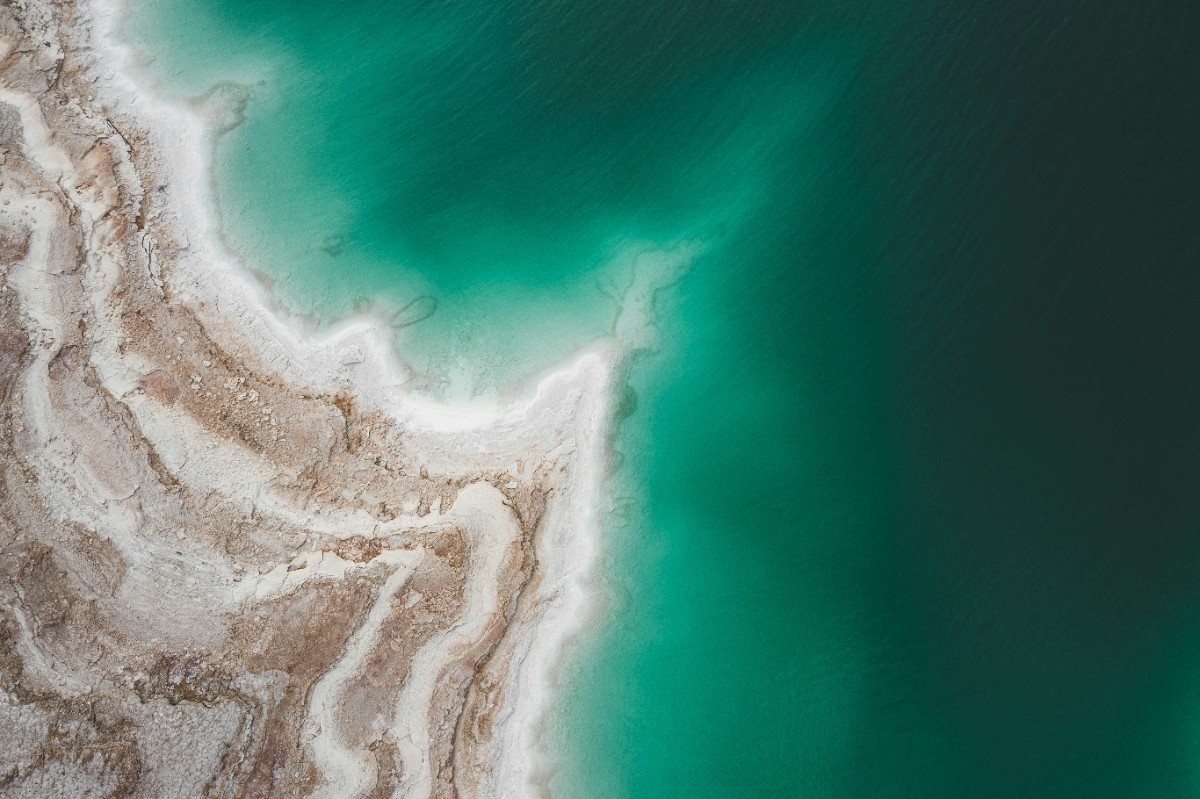The Dead Sea: A Geographical Wonder
Location and Physical Characteristics
The Dead Sea, also known as the Salt Sea, is a landlocked salt lake situated in the Jordan Rift Valley, bordering Jordan to the east and Israel and the West Bank to the west. It is the lowest point on Earth, with its surface and shores located approximately 430.5 meters (1,412 feet) below sea level. The Dead Sea is about 50 kilometres (31 miles) long and 15 kilometres (9 miles) wide at its widest point. The lake is fed by the Jordan River, but due to its unique geographical setting and high evaporation rates, the Dead Sea has no outlet, resulting in the accumulation of minerals and salts in its waters.
Geology and Formation
The Dead Sea's formation is closely linked to the geological history of the Jordan Rift Valley, which began around 3 million years ago. The valley formed as a result of the separation of the African and Arabian tectonic plates, creating a deep depression that gradually filled with water from the Jordan River and other tributaries. Over time, as the water evaporated in the arid climate, it left behind a concentrated solution of salts and minerals, giving rise to the Dead Sea's unique chemical composition. The lake is situated on top of deep sedimentary layers that have accumulated over millions of years, providing valuable insights into the region's geological and climatic history.
Hydrological Features
The Dead Sea is an endorheic basin, meaning that it has no outflow to the ocean. The primary water source for the lake is the Jordan River, which flows from the north and accounts for approximately 90% of the lake's total inflow. Other tributaries, such as the Zarqa River from Jordan and various wadis (seasonal streams) from Israel and the West Bank, also contribute to the lake's water balance. However, the high evaporation rates in the region, coupled with the diversion of water from the Jordan River for agricultural and industrial purposes, have led to a significant decrease in the Dead Sea's water level in recent decades.
Climate and Environmental Conditions
The Dead Sea region is characterised by a hot and arid climate, with average temperatures ranging from 20°C (68°F) in the winter to 32°C (90°F) in the summer. The area receives minimal rainfall, with an average of only 50-100 millimetres (2-4 inches) per year, primarily occurring during the winter months. The high temperatures and low humidity contribute to the high evaporation rates, which can reach up to 1,500 millimetres (59 inches) per year. These unique climatic conditions, combined with the lake's low elevation and hypersaline waters, create a distinctive environment that supports a variety of adapted flora and fauna, as well as a thriving mineral extraction industry.
The Therapeutic Properties of the Dead Sea
Mineral Composition and Salinity
The Dead Sea is renowned for its unique mineral composition and high salinity, which contribute to its therapeutic properties. The lake's water contains a high concentration of minerals, including magnesium, potassium, calcium, bromide, and sulphates, with a total salt concentration of approximately 34%, making it nearly ten times saltier than ocean water. This distinctive mineral composition is a result of the Dead Sea's unique geographical setting and the continuous evaporation of water, which leaves behind a rich mixture of salts and minerals. The high salinity also contributes to the lake's famous buoyancy, allowing swimmers to float effortlessly on its surface.
Skin Conditions and Treatments
The mineral-rich waters and mud of the Dead Sea have been used for centuries to treat various skin conditions, such as psoriasis, eczema, and acne. The high concentration of magnesium, in particular, is known for its anti-inflammatory and moisturising properties, which can help alleviate symptoms and promote healing. Soaking in the Dead Sea water or applying its mud as a topical treatment can help to exfoliate, cleanse, and nourish the skin, improving its overall health and appearance. Many visitors to the Dead Sea report significant improvements in their skin conditions after undergoing treatments at the lake's numerous spa and wellness facilities.
Respiratory Benefits
The Dead Sea's unique atmospheric conditions, characterised by high barometric pressure and a high concentration of bromide and other minerals, are believed to have beneficial effects on respiratory health. The air near the lake's surface is rich in bromine, which has natural antibiotic and anti-inflammatory properties. Inhaling this mineral-rich air can help alleviate symptoms of respiratory conditions such as asthma, bronchitis, and allergies. Additionally, the high barometric pressure at the Dead Sea's low elevation can increase oxygen intake, further promoting respiratory well-being.
Musculoskeletal and Rheumatic Disorders
The Dead Sea's warm, mineral-rich waters and mud have been used to treat various musculoskeletal and rheumatic disorders, such as rheumatoid arthritis, osteoarthritis, and fibromyalgia. The high concentration of minerals, particularly magnesium and sulphates, can help reduce inflammation, relieve pain, and improve joint mobility. The natural buoyancy of the Dead Sea water also provides a gentle, supportive environment for exercise and rehabilitation, allowing patients to perform therapeutic movements with reduced stress on their joints and muscles. Many specialised clinics and resorts along the Dead Sea shoreline offer comprehensive treatment programs that combine balneotherapy (mineral water treatments), physiotherapy, and mud applications to address a wide range of musculoskeletal conditions.
Relaxation and Stress Relief
Beyond its specific therapeutic applications, the Dead Sea is also renowned as a destination for relaxation and stress relief. The tranquil surroundings, coupled with the unique sensation of floating in the mineral-rich waters, can promote a deep sense of relaxation and well-being. Many visitors report feeling a profound sense of calmness and rejuvenation after spending time at the Dead Sea, making it an increasingly popular destination for wellness tourism. The numerous spas, resorts, and wellness centres along the lake's shores offer a variety of treatments and activities designed to promote relaxation, including massages, meditation, and yoga, all enhanced by the Dead Sea's natural therapeutic properties.
The Dead Sea's Unique Ecosystem
Hypersaline Environment and Microbial Life
Despite its name, the Dead Sea is not entirely devoid of life. The lake's hypersaline environment, with a salt concentration nearly ten times higher than that of ocean water, poses challenges for most organisms. However, a variety of microorganisms, known as halophiles, have adapted to thrive in these extreme conditions. These include halophilic archaea, such as Haloarcula marismortui and Haloferax volcanii, and halophilic bacteria, such as Salinibacter ruber. These microorganisms play a crucial role in the Dead Sea's unique ecosystem, acting as primary producers and contributing to nutrient cycling. Their ability to survive in such a harsh environment has also made them a subject of interest for researchers studying the limits of life and the potential for extraterrestrial organisms.
Freshwater Springs and Oases
While the Dead Sea itself is too salty to support most forms of life, the surrounding area is dotted with freshwater springs and oases that provide habitats for a diverse array of plants and animals. These wetlands, fed by underground aquifers and seasonal streams, create pockets of lush vegetation in the otherwise arid landscape. The Ein Gedi oasis, located on the western shore of the Dead Sea, is one of the most well-known examples, hosting a variety of plant species, including the Sodom apple (Calotropis procera), the Dead Sea tamarisk (Tamarix jordanis), and the rare Sudanese Dead Sea sparrow (Passer moabiticus). These oases also serve as important stopover sites for migratory birds, providing them with a crucial source of freshwater and food during their long journeys.
Adaptations of Flora and Fauna
The harsh environmental conditions around the Dead Sea, characterised by high salinity, intense solar radiation, and limited water availability, have driven the evolution of unique adaptations in the region's flora and fauna. Many plants, such as the Dead Sea glasswort (Salicornia persica) and the Dead Sea plantain (Plantago coronopus), have developed specialised mechanisms to cope with the high salt content in the soil, such as salt glands and succulent leaves. Animals in the area have also adapted to the challenging conditions, with species like the Dead Sea toad (Sclerophrys rugosa) and the Dead Sea beetle (Anisodactylus nemorivagus) exhibiting behaviours and physiological traits that allow them to survive in the harsh desert environment.
Environmental Threats and Conservation Efforts
Despite its unique and resilient ecosystem, the Dead Sea and its surrounding area face numerous environmental threats. The most pressing issue is the rapidly declining water level, caused by the diversion of water from the Jordan River for agricultural and industrial purposes, as well as the effects of climate change. As the Dead Sea's surface recedes, it exposes vast areas of the lakebed, leading to the formation of sinkholes and the degradation of surrounding habitats. The mineral extraction industry, while economically important, also contributes to the environmental strain on the region. Conservation efforts, such as the proposed Red Sea-Dead Sea Water Conveyance Project and the establishment of nature reserves, aim to mitigate these threats and protect the Dead Sea's unique ecosystem for future generations.
The Dead Sea's Mineral Resources and Industry
Formation and Composition of Mineral Deposits
The Dead Sea's unique geographical setting and high evaporation rates have led to the formation of extensive mineral deposits, both in the lake itself and in the surrounding area. The primary minerals found in the Dead Sea include potash (potassium chloride), bromine, magnesium, calcium chloride, and sodium chloride (common salt). These minerals have accumulated over millions of years as a result of the continuous inflow of water from the Jordan River and other tributaries, coupled with the high evaporation rates in the region. The Dead Sea's mineral composition is further influenced by the complex geology of the area, with ancient salt deposits and sedimentary layers contributing to the lake's unique chemical profile.
Potash Extraction and Fertiliser Production
Potash, a potassium-rich salt, is one of the most valuable minerals extracted from the Dead Sea. It is primarily used in the production of fertilisers, as potassium is an essential nutrient for plant growth. The Dead Sea is estimated to contain over 2 billion tons of potash, making it one of the world's largest sources of this mineral. The extraction process involves pumping water from the lake into large evaporation ponds, where the potash crystallises and is then harvested. The potash industry plays a significant role in the economies of Israel and Jordan, with companies like the Arab Potash Company and the Dead Sea Works Ltd. operating large-scale extraction and processing facilities along the lake's shores.
Bromine Extraction and Industrial Applications
Bromine, another important mineral resource found in the Dead Sea, is used in a wide range of industrial applications, including the production of flame retardants, pharmaceuticals, and agricultural chemicals. The Dead Sea is the world's largest source of bromine, with an estimated concentration of 5,000 parts per million (ppm) in its waters. The extraction process is similar to that of potash, with the bromine-rich water being pumped into evaporation ponds, where the mineral is collected and processed. The Israel Chemicals Ltd. (ICL) Group is a major player in the Dead Sea bromine industry, operating a large extraction and processing facility at the southern end of the lake.
Magnesium and Other Mineral Extraction
The Dead Sea is also a significant source of magnesium, with an estimated concentration of 40,000 ppm in its waters, the highest of any natural body of water on Earth. Magnesium is used in the production of lightweight alloys, ceramics, and refractory materials, among other applications. The extraction process involves the precipitation of magnesium salts from the Dead Sea water, followed by further processing to produce magnesium metal and other products. In addition to magnesium, the Dead Sea is also a source of calcium chloride, sodium chloride, and other valuable minerals, which are extracted and processed for various industrial and commercial uses.
Environmental Impact and Sustainability Challenges
While the mineral extraction industry has brought significant economic benefits to the region, it has also contributed to the environmental challenges facing the Dead Sea. The large-scale evaporation ponds used in the extraction process have accelerated the decline in the lake's water level, exacerbating the problems of sinkholes and habitat degradation. The discharge of brine and other industrial byproducts into the Dead Sea has also raised concerns about the long-term impacts on the lake's unique ecosystem. As the demand for the Dead Sea's mineral resources continues to grow, it is crucial that the industry adopts sustainable practices and works to minimise its environmental footprint, ensuring that this precious natural wonder can be preserved for future generations.
The Dead Sea in Religious and Cultural Traditions
Biblical References and Significance
The Dead Sea and its surrounding area hold a prominent place in the religious traditions of Judaism, Christianity, and Islam. In the Hebrew Bible (Old Testament), the Dead Sea is referred to as the "Salt Sea" or the "Sea of the Arabah," and is mentioned in several key events. One of the most well-known biblical stories associated with the region is the destruction of Sodom and Gomorrah, two cities that were said to have been located near the Dead Sea and were destroyed by God due to the wickedness of their inhabitants. The Dead Sea is also mentioned in the context of battles, such as the war between King David and the Edomites, and as a boundary marker for the territories of the Israelite tribes.
The Essenes and the Dead Sea Scrolls
The Dead Sea region is closely linked to the history of the Essenes, a Jewish sect that flourished during the Second Temple period (516 BCE - 70 CE). The Essenes are believed to have been the custodians of the Dead Sea Scrolls, a collection of ancient Jewish and Hebrew religious manuscripts that were discovered in the Qumran Caves near the Dead Sea between 1947 and 1956. The scrolls, which include the oldest known copies of the Hebrew Bible and other religious texts, have provided invaluable insights into the history of Judaism and the development of early Christianity. The Qumran ruins, located on the northwestern shore of the Dead Sea, are believed to have been the main settlement of the Essene community and have become an important pilgrimage site for scholars and religious enthusiasts.
Early Christian Traditions and Pilgrimage Sites
The Dead Sea region also holds significance in early Christian traditions, particularly in connection with the life and ministry of John the Baptist. According to the Gospels, John the Baptist conducted his baptismal ministry in the wilderness near the Jordan River, which flows into the Dead Sea. The Qasr el-Yahud site, located on the Jordan River just north of the Dead Sea, is believed to be the location where John the Baptist baptised Jesus Christ and has become an important pilgrimage site for Christians. Other early Christian monasteries and churches, such as the Monastery of Saint George of Choziba and the Church of the Good Shepherd in Jericho, are also located in the Dead Sea region and have attracted pilgrims and visitors for centuries.
Islamic Traditions and the Dead Sea
Although the Dead Sea is not directly mentioned in the Quran, the region holds significance in Islamic traditions as well. The city of Jericho, located near the northern shore of the Dead Sea, is mentioned in the Quran as the place where the prophet Moses and the Israelites camped after their exodus from Egypt. The Tomb of Moses (Maqam Nabi Musa), a Muslim shrine located near Jericho, is believed to be the burial place of Moses and has become an important pilgrimage site for Muslims. The Dead Sea region is also associated with the life of the prophet Lot, who is mentioned in the Quran as a righteous man who preached against the wickedness of Sodom and Gomorrah.
Cultural Heritage and Tourism
The rich religious and cultural heritage of the Dead Sea region has made it an important destination for tourism and pilgrimage. Visitors from around the world come to explore the ancient ruins, religious sites, and natural wonders of the area, contributing to the local economy and promoting cultural exchange. However, the growth of tourism has also brought challenges, such as increased pressure on the environment and the need to balance preservation with development. Efforts to promote sustainable tourism practices and protect the cultural heritage of the Dead Sea region are ongoing, with initiatives such as the UNESCO World Heritage Site designation for the Qumran ruins and the development of eco-tourism projects aimed at preserving the unique character of this iconic landscape.
Environmental Challenges and Conservation Efforts in the Dead Sea Region
Declining Water Levels and the Need for Intervention
The most pressing environmental challenge facing the Dead Sea is the rapid decline in its water level, which has fallen by over a meter per year in recent decades. This decline is primarily due to the diversion of water from the Jordan River, the Dead Sea's main tributary, for agricultural and industrial purposes in Israel, Jordan, and Syria. The reduced inflow, combined with the high evaporation rates in the region, has led to a significant reduction in the Dead Sea's surface area and volume. If current trends continue, the Dead Sea could disappear entirely within a matter of decades, with devastating consequences for the region's unique ecosystem and the communities that depend on it. Urgent intervention is needed to address this crisis, including measures to reduce water consumption, improve water management, and explore alternative water sources.
Sinkholes and Geologic Instability
As the Dead Sea's water level declines, it exposes large areas of the lakebed that were previously submerged. These exposed areas are prone to the formation of sinkholes, which occur when underground salt layers dissolve and cause the overlying soil and rock to collapse. Sinkholes can be several meters deep and wide, posing a serious risk to human safety and infrastructure. In recent years, thousands of sinkholes have formed along the Dead Sea's shoreline, damaging roads, buildings, and agricultural land. The increasing frequency and severity of sinkhole formation is a direct consequence of the Dead Sea's declining water levels and highlights the urgent need for action to address this environmental crisis. Geologists and engineers are working to develop strategies to monitor and mitigate sinkhole risk, but ultimately, the long-term solution lies in restoring the Dead Sea's water balance.
Impact on Biodiversity and Ecosystems
The Dead Sea's unique ecosystem, characterised by its hypersaline waters and the freshwater oases that dot its shoreline, is home to a diverse array of plant and animal species, many of which are found nowhere else on Earth. However, the declining water levels and increasing salinity of the Dead Sea are putting these species at risk. As the lake shrinks, the freshwater oases that provide critical habitat for many species are drying up, while the increasing salinity makes it harder for even the most salt-tolerant organisms to survive. The Dead Sea's decline also has ripple effects on the surrounding desert ecosystems, as the lake's moderating influence on the local climate diminishes. Conservation efforts, such as the establishment of nature reserves and the protection of key habitats, are crucial to preserving the Dead Sea's unique biodiversity in the face of these challenges.
Strategies and Initiatives for Restoration
Addressing the environmental challenges facing the Dead Sea will require a coordinated effort from governments, industries, and communities in the region. One of the most ambitious proposals is the Red Sea-Dead Sea Water Conveyance Project, which aims to pump water from the Red Sea to the Dead Sea to stabilise water levels and generate hydroelectric power. However, this project has faced criticism for its potential environmental impacts and high costs. Other strategies focus on improving water management and reducing consumption, such as implementing more efficient irrigation practices and promoting water conservation in urban areas. There are also efforts to restore and protect key habitats, such as the Jordan River Valley, through reforestation, wetland rehabilitation, and sustainable land management practices. Ultimately, the success of these initiatives will depend on the commitment and cooperation of all stakeholders in the region, as well as the support of the international community.
The Future of the Dead Sea: Balancing Economic Development and Environmental Sustainability
Sustainable Tourism Development
Tourism is a major economic driver in the Dead Sea region, with millions of visitors each year drawn to the lake's unique natural and cultural attractions. However, the growth of tourism has also contributed to the environmental pressures facing the Dead Sea, from increased water consumption to the development of infrastructure in sensitive areas. To ensure that tourism can continue to benefit the region's economy without compromising its environmental integrity, a more sustainable approach is needed. This could include measures such as promoting eco-tourism activities, developing low-impact accommodation options, and encouraging visitors to reduce their water and energy consumption. By working with local communities and businesses to develop a shared vision for sustainable tourism, the Dead Sea region can continue to attract visitors while preserving its unique natural and cultural heritage for future generations.
Supporting Local Communities and Traditional Livelihoods
The communities that live around the Dead Sea, including both Jewish and Arab populations, have deep cultural and economic ties to the lake and its surrounding landscape. However, the environmental challenges facing the region, from declining water levels to the formation of sinkholes, are putting these traditional livelihoods at risk. Supporting these communities and helping them adapt to changing conditions will be crucial to ensuring a sustainable future for the Dead Sea region. This could include measures such as promoting sustainable agriculture practices, developing alternative livelihood options, and investing in education and training programs to help local residents acquire new skills. By empowering local communities to become stewards of their environment and active participants in conservation efforts, the Dead Sea region can build a more resilient and sustainable future.
Collaborative Research and Knowledge Sharing
Given the complexity of the environmental challenges facing the Dead Sea region, there is an urgent need for ongoing research and knowledge sharing to inform conservation and development efforts. This could include collaborative initiatives between universities, research institutions, and government agencies to study the Dead Sea's unique ecology, monitor environmental changes, and develop innovative solutions to address challenges such as water scarcity and sinkhole formation. By fostering a culture of open science and knowledge sharing, the Dead Sea region can benefit from the collective expertise of researchers and practitioners from around the world. This could also include efforts to engage local communities in citizen science projects and to incorporate traditional ecological knowledge into conservation strategies.
Transboundary Cooperation and Governance
The Dead Sea is a shared resource, bordered by Israel, Jordan, and the Palestinian Territories. Effective conservation and management of the lake and its surrounding landscape will require close cooperation and coordination between these different jurisdictions. This could include the development of joint management plans, the harmonisation of environmental regulations, and the establishment of transboundary protected areas. By working together to address common challenges and pursue shared goals, the countries of the Dead Sea region can achieve more than they could alone. This will require political will, as well as the support of international organisations and donor agencies to facilitate dialogue, build trust, and provide technical and financial assistance. Ultimately, the future of the Dead Sea will depend on the ability of all stakeholders to come together in a spirit of cooperation and shared responsibility.
Building Resilience and Adapting to Change
Looking to the future, it is clear that the Dead Sea region will continue to face significant environmental challenges, from climate change to water scarcity to population growth. Building resilience and adapting to these changing conditions will be essential to ensuring a sustainable future for the region's communities and ecosystems. This could include measures such as investing in climate-resilient infrastructure, promoting sustainable land management practices, and developing early warning systems for natural hazards such as sinkholes and flash floods. It will also require a willingness to embrace new approaches and technologies, from renewable energy to desalination to green infrastructure. By proactively planning for and adapting to change, the Dead Sea region can position itself as a model for sustainable development in a changing world.
Related Articles

Let us know you agree to cookies
We use marketing, analytical and functional cookies as well as similar technologies to give you the best experience. Third parties, including social media platforms, often place tracking cookies on our site to show you personalised adverts outside of our website.
We store your cookie preferences for two years and you can edit your preferences via ‘manage cookies’ or through the cookie policy at the bottom of every page. For more information, please see our cookie policy.
